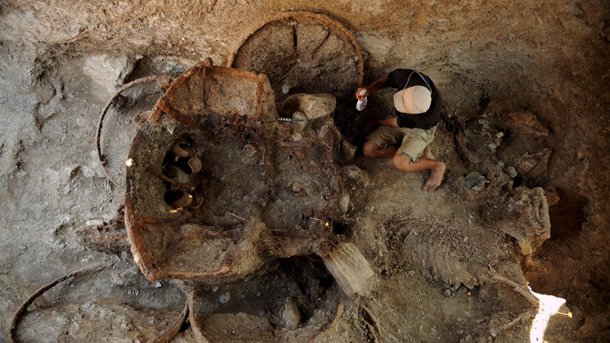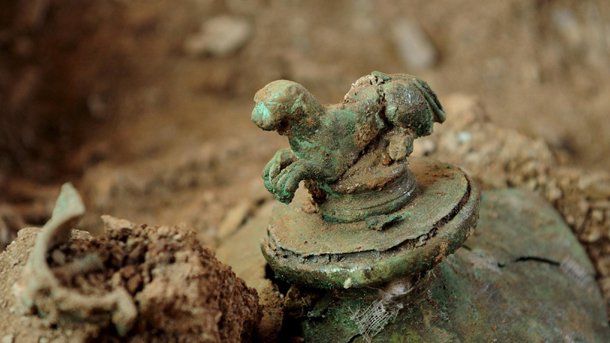In late September it transpired that the team of archeologists led by Daniela Agre had found rich grave goods in a Thracian tomb near the village of Borissovo, Yambol region in Southeastern Bulgaria. The tomb was the burial ground of a young maid, who had lived at the end of the 1st and the beginning of the 2nd c. AD. She was a member of a noble family, who had been buried in two separate mounds next to her tomb. Evidence of this is the resemblance between the grave goods discovered in all three sites. The team explored the first tomb in 2008. One of the most interesting finds was a beautifully preserved chariot of a Thracian aristocrat. The second tomb contained bronze luxury objects – a small round table, some 90 cm in height, a large dish that in all likelihood was used to serve fruits.
“We even found a utensil to which we have not found a name yet, but which we jestingly called “champagne bucket”, because it resembled a small bucket containing a utensil with a lid on top,” Daniela Agre explains. “We believe it was used for cooling drinks. The very design of the grave was of particular interest to us, because I had never before seen anything like that in scientific papers or in my experience. The bottom of the grave was covered with walnuts. We also dug out three pairs of shoes. A large number of the findings have already been exhibited at the Museum of Ethnography and Archeology in the town of Elhovo, while others still need restoration and conservation.”
A rare gift is how Daniela Agre called the eagle-head decorations of the ancient chariots. A few of them have been unearthed in the Bulgarian lands.
“I would not exaggerate if I said that the ones represented in the Borissovo mound were the most exquisite and refined,” Daniela Agre argues. “Every single feather is visible, and the predatory look of the birds is really tangible. They had been placed on top the four upper ends of the chariot. The man who had crafted them must have been a real master. They rank among the most beautiful metal artifacts made during that age in our lands.”

© Photo: BGNES
For several years the team led by Dr. Agre has been studying mounds in the vicinity dating back to the 1st-2nd c. AD. In one of them near the village of Stoyno they discovered a cremated chariot with horses, as well as a remarkable collection of bronze vessels.
“I guess at that time a few rich Thracian landowners and I might even say, aristocrats, used to live with their families along the River Tundzha,” Daniela Agre continues. “We studied the grave goods in 2008 and 2011. In 2009 near the village of Boyanovo we dug out the grave of a young girl, which contained interesting artifacts brought from outside. She had a golden earpiece on her mouth. This is a ritual that was common in Mycena in the 2nd millennium BC. But later evidence of this was found in the early iron age in various places in Thrace. We see how it had carried over to the first centuries of the new era.”

© Photo: BGNES
The tribes that populated the area used to have good ties with the East and the West, as well as with the Greek civilization. Her team studied another interesting archeological site – the solidly fortified residence of a local ruler near the present-day town of Koprivshtitza, Central Bulgaria. The digs have been going on for a fifth season now. The solid stone building has walls some 3 m in width. The blocks used to build the edifice weigh 600-700 kg each. The building used to have two storeys and a court yard with an area of nearly 250 square metres. It used to be populated in the first half of the 4th c. BC and then again a few centuries later, at the end of the 1st, and also in the 2nd and 3rd c. AD. Its function however had changed – from a fortified residence to a Thracian sanctuary.
The archeologists have been working currently on a mound near the town of Topolovgrad, Southeastern Bulgaria. They discovered the respectable façade of an edifice. The artifacts they have unearthed so far date it back to the Hellenistic age, i.e. the end of the 4th – end of the 1st c. BC.
English version: Radostin Zhelev
Christmas Eve is one of those quiet family holidays, filled with hope for the future. At the border between the past and the present, Orthodox Bulgarians gather to welcome the days to come. Traditionally, the table on Christmas Eve is simple and..
Today, the Bulgarian Orthodox Church commemorates St. Naum of Ohrid. Naum was a medieval Bulgarian scholar and writer. He was born around 830 and died on December 23, 910. He was of noble origin but he left everything and followed the Slavic..
With the blessing of His Eminence Metropolitan Arsenii of Sliven, a copy of the miraculous Athonite icon of the Most Holy Theotokos "She Who is Quick to Hear" was welcomed at the Saint George the Victorious Monastery in Pomorie. The Bulgarian..

+359 2 9336 661
